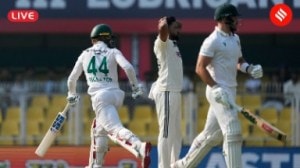Obama widens missile strikes inside Pakistan: Report
After targeting al-Qaeda and Taliban militants in their 'safe havens' on the Pak-Afghan border,US forces have now also started hitting Pakistani Taliban. US President Barack Obama has broadened the list of radical groups to be targeted by the CIA,'The New York Times' reported.
After targeting al-Qaeda and Taliban militants in their ‘safe havens’ on the Pak-Afghan border,US forces have now also started hitting Pakistani Taliban.
US President Barack Obama has broadened the list of radical groups to be targeted by the Central Intelligence Agency (CIA) and the group led by Baitullah Mehsud is one of them,’The New York Times’ reported.
The strikes are another sign that Obama is continuing,and in some cases extending,Bush administration policy in using American spy agencies against terrorism suspects in Pakistan,as he had promised to do during his Presidential campaign.
The missile strikes on training camps run by Baitullah Mehsud represent a broadening of the American campaign inside Pakistan,which has been largely carried out by drone aircraft.
Last week,American drones attacked a camp run by Hakeem Ullah Mehsud,a top aide to the militant leader. But the Pakistani Taliban chief himself was not killed.
By striking at the Mehsud network,US may be seeking to demonstrate to Pakistan President Asif Ali Zardari that the new administration is willing to go after the insurgents of greatest concern to Pakistani leaders.
But American officials may also be prompted by growing concern that the militant attacks are increasingly putting the civilian government of Pakistan,a nation with nuclear weapons,at risk.
Mehsud was identified early last year by both American and Pakistani officials as the man who had orchestrated the assassination of Benazir Bhutto,the former Prime Minister and the wife of Pakistan’s current President,Asif Ali Zardari.
Bush included Mehsud’s name in a classified list of militant leaders whom the CIA and American commandos were authorised to capture or kill.
For months,Pakistani military and intelligence officials have complained about Washington’s refusal to strike at Baitullah Mehsud,even while CIA drones struck at Qaeda figures and leaders of the network run by Jalaluddin Haqqani,a militant leader believed responsible for a campaign of violence against American troops in Afghanistan.
According to one senior Pakistani official,Pakistans intelligence service on two occasions in recent months gave the United States detailed intelligence about Mehsud’s whereabouts,but said the United States had not acted on the information.
Bush administration officials had charged that it was the Pakistanis who were reluctant to take on Mehsud and his network,the paper reported.
The strikes came after a visit to Islamabad last week by Richard C. Holbrooke,the American envoy to Pakistan and Afghanistan.
But Obama administration officials face the same intractable problems that the Bush administration did in trying to prod Pakistan toward a different course,the New York Times reported.
Pakistan still deploys the overwhelming majority of its troops along the Indian border,not the border with Afghanistan,and its intelligence agencies maintain shadowy links to the Taliban even as they take American funds to fight them.
Under standard policy for covert operations,the CIA strikes inside Pakistan have not been publicly acknowledged either by the Obama administration or the Bush administration.
Using Predators and the more heavily armed Reaper drones,the CIA has carried out more than 30 strikes since last September,according to American and Pakistani officials.
The attacks have killed a number of senior Qaeda figures,including Abu Jihad al-Masri and Usama al-Kini,who is believed to have helped plan the 1998 American Embassy bombings in East Africa and 2008s bombing of the Marriott Hotel in Islamabad.



- 01
- 02
- 03
- 04
- 05




























